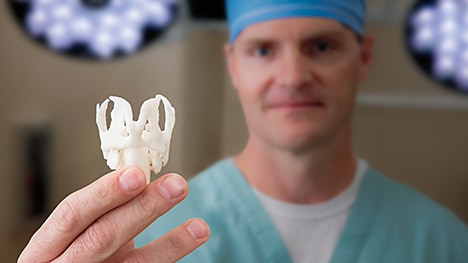Man With Transplanted Voice Box Speaking Again
Giving Them Their Vox
New strategies could brand laryngectomies a thing of the past

David Lott, M.D., and his team are developing a larynx fully regenerated from a person's ain stem cells harvested from fat tissue.
Today, about lx,000 Americans have had their larynx removed due to disease or trauma. These people are missing out on many of life'south little pleasures because the procedure's resultant hole left them without a voice and created an opening straight into their lungs. A simple shower is dangerous every bit even the slightest corporeality of water in the lungs tin be deadly. Bad weather tin be lethal. Things that used to exist a mere annoyance — such equally a housefly — are now life-threatening.
It's not overstating it to say that danger lurks everywhere subsequently a laryngectomy. And just at the time yous need extra support, your ability to communicate is greatly impaired. A simple interaction with a store clerk is frustrating and tin can deliver looks of horror and compassion.
Every bit an ear, nose and throat specialist at Mayo Clinic, David Lott, M.D., has seen laryngectomies impair too many lives.
"I'm tired of seeing patients over and over and knowing at that place's nada to do," he says. Some patients become so hopeless in the face of a laryngectomy that they forgo the procedure, opting for sure expiry over such deeply dumb living.
Dr. Lott wants to restore hope for these people. And with the latest breakthroughs in transplant and regenerative medicine, he knows how.
The outset strategy
Dr. Lott and his team at Mayo Clinic are a step ahead of the rest of the nation in giving people without a larynx new options.
Their commencement strategy is larynx transplant.
The procedure has only been performed three times in countries with avant-garde medicine.
Dr. Lott has established an exclusive set up of protocols that helped create a new Head and Neck Transplantation Program at Mayo Clinic in Arizona. The United Network for Organ Sharing — the transplantation regulating system — gave the protocols the greenish light so Dr. Lott and his team can perform two transplantations per year for the adjacent v years. If all goes as the team expects, larynx transplant will become as routine as any other transplant such every bit heart, liver or kidney.
"Laryngeal transplantation volition allow people to odour, taste, eat and communicate in a voice uniquely one's ain," Dr. Lott says. "It many cases, it tin can be lifesaving."
Larynx transplant could benefit about threescore,000 people in the U.s. alone, merely the process isn't without drawbacks. The first is organ availability. Like nearly all transplantable organs, there just aren't enough to go around. The second is that not all laryngectomy patients would qualify for a larynx transplant. The third is that those who practise have the process must immediately brainstorm a regimen of immunosuppression drugs and so their torso doesn't assault the new organ. The drugs have to exist taken every day for the rest of their lives, yet there still remains a chance of organ rejection.
Dr. Lott'south second strategy of building a whole new organ, on need, would overcome all of these drawbacks.
The 2d strategy
In the past few years, regenerative medicine has begun to deliver on the long promise of growing new organs from stem cells harvested from a patient's own trunk. Mayo Clinic will soon host a terminal-phase clinical trial that treats damaged heart muscle with stalk cells harvested from os marrow and treated with specific growth factors. It'due south just i of more than forty clinical trials Mayo Dispensary'due south Heart for Regenerative Medicine is conducting.
The center is driving regenerative techniques throughout Mayo Dispensary's research and practice by building an infrastructure that practitioners can use to apply to their own work. For instance, a researcher interested in applying stem cells to an eye disease tin can use center resources to extract cells, treat the cells with relevant growth factors, grow them into the necessary numbers for treatment and evangelize them back to the patient. It reduces the learning bend from years to months. As a result, researchers tin can easily explore how regenerative medicine can help their patients.
Dr. Lott says at that place'southward little question that regenerative medicine will aid his patients. In fact, he has already developed an implantable organ and is working with the Food and Drug Administration to launch a clinical trial by end of the year.
The procedure begins with highly accurate imaging of a person's larynx. Dr. Lott's team so uses 3-D press to reconstruct the damaged portion of the organ. They use this as a mold to create a scaffold that will guide the stem cells equally they grow. To become the stem cells, researchers take a sample of a person's fatty tissue and transfer information technology to a specific medium in a culture dish. The fat cells float to the top and the stem cells sink to the bottom, making them piece of cake to harvest. Researchers employ specific growth factors to begin transforming them into larynx cells and expand their numbers.
Once the scaffold and stem cells are gear up, researchers identify both in a bioreactor that rotates the scaffold through the civilization media, much like a self-basting rotisserie. After two weeks, the tissue is ready for transplant.
The whole process is iii to 4 weeks.
"Regenerative medicine enables united states to reconstruct defects and restore office to tissue without the demand for immunosuppression in ways that were previously unthinkable," Dr. Lott says. "This ability ways that patients take fewer handling risks, recover sooner, role amend and take a amend quality of life. In many cases, it preserves life itself."
Give patients back their voices by supporting Dr. Lott and Mayo Dispensary'southward Center for Regenerative Medicine.
.
Source: https://www.mayoclinic.org/giving-to-mayo-clinic/philanthropy-in-action/features-stories/giving-them-their-voice
0 Response to "Man With Transplanted Voice Box Speaking Again"
Post a Comment